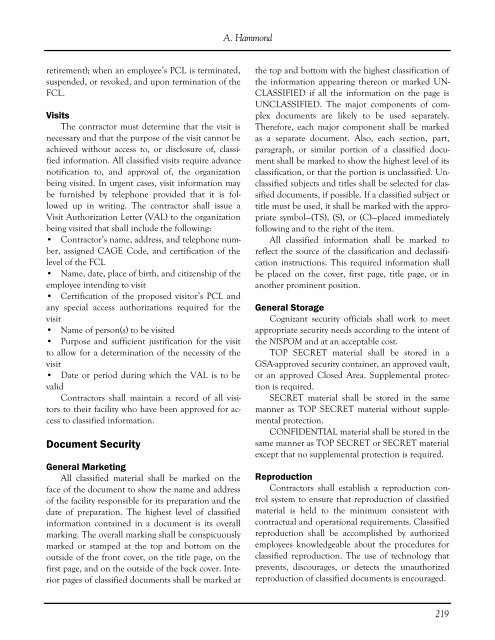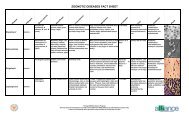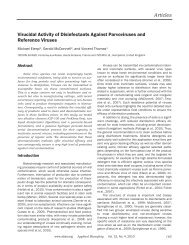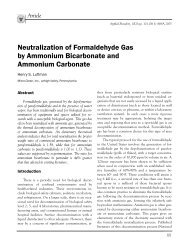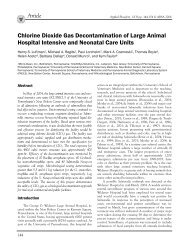Volume 10, Number 4, 2005 - American Biological Safety Association
Volume 10, Number 4, 2005 - American Biological Safety Association
Volume 10, Number 4, 2005 - American Biological Safety Association
You also want an ePaper? Increase the reach of your titles
YUMPU automatically turns print PDFs into web optimized ePapers that Google loves.
etirement); when an employee’s PCL is terminated,<br />
suspended, or revoked, and upon termination of the<br />
FCL.<br />
Visits<br />
The contractor must determine that the visit is<br />
necessary and that the purpose of the visit cannot be<br />
achieved without access to, or disclosure of, classified<br />
information. All classified visits require advance<br />
notification to, and approval of, the organization<br />
being visited. In urgent cases, visit information may<br />
be furnished by telephone provided that it is followed<br />
up in writing. The contractor shall issue a<br />
Visit Authorization Letter (VAL) to the organization<br />
being visited that shall include the following:<br />
• Contractor’s name, address, and telephone number,<br />
assigned CAGE Code, and certification of the<br />
level of the FCL<br />
• Name, date, place of birth, and citizenship of the<br />
employee intending to visit<br />
• Certification of the proposed visitor’s PCL and<br />
any special access authorizations required for the<br />
visit<br />
• Name of person(s) to be visited<br />
• Purpose and sufficient justification for the visit<br />
to allow for a determination of the necessity of the<br />
visit<br />
• Date or period during which the VAL is to be<br />
valid<br />
Contractors shall maintain a record of all visitors<br />
to their facility who have been approved for access<br />
to classified information.<br />
Document Security<br />
General Marketing<br />
All classified material shall be marked on the<br />
face of the document to show the name and address<br />
of the facility responsible for its preparation and the<br />
date of preparation. The highest level of classified<br />
information contained in a document is its overall<br />
marking. The overall marking shall be conspicuously<br />
marked or stamped at the top and bottom on the<br />
outside of the front cover, on the title page, on the<br />
first page, and on the outside of the back cover. Interior<br />
pages of classified documents shall be marked at<br />
A. Hammond<br />
the top and bottom with the highest classification of<br />
the information appearing thereon or marked UN-<br />
CLASSIFIED if all the information on the page is<br />
UNCLASSIFIED. The major components of complex<br />
documents are likely to be used separately.<br />
Therefore, each major component shall be marked<br />
as a separate document. Also, each section, part,<br />
paragraph, or similar portion of a classified document<br />
shall be marked to show the highest level of its<br />
classification, or that the portion is unclassified. Unclassified<br />
subjects and titles shall be selected for classified<br />
documents, if possible. If a classified subject or<br />
title must be used, it shall be marked with the appropriate<br />
symbol—(TS), (S), or (C)—placed immediately<br />
following and to the right of the item.<br />
All classified information shall be marked to<br />
reflect the source of the classification and declassification<br />
instructions. This required information shall<br />
be placed on the cover, first page, title page, or in<br />
another prominent position.<br />
General Storage<br />
Cognizant security officials shall work to meet<br />
appropriate security needs according to the intent of<br />
the NISPOM and at an acceptable cost.<br />
TOP SECRET material shall be stored in a<br />
GSA-approved security container, an approved vault,<br />
or an approved Closed Area. Supplemental protection<br />
is required.<br />
SECRET material shall be stored in the same<br />
manner as TOP SECRET material without supplemental<br />
protection.<br />
CONFIDENTIAL material shall be stored in the<br />
same manner as TOP SECRET or SECRET material<br />
except that no supplemental protection is required.<br />
Reproduction<br />
Contractors shall establish a reproduction control<br />
system to ensure that reproduction of classified<br />
material is held to the minimum consistent with<br />
contractual and operational requirements. Classified<br />
reproduction shall be accomplished by authorized<br />
employees knowledgeable about the procedures for<br />
classified reproduction. The use of technology that<br />
prevents, discourages, or detects the unauthorized<br />
reproduction of classified documents is encouraged.<br />
219


